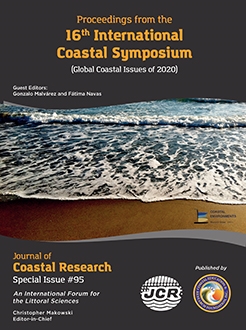Wu, T. and Qin, J., 2020. Influence of flow and sediment transport processes on sedimentation in groyne fields. In: Malvárez, G. and Navas, F. (eds.), Global Coastal Issues of 2020. Journal of Coastal Research, Special Issue No. 95, pp. 304-308. Coconut Creek (Florida), ISSN 0749-0208.
Groynes have been widely used to prevent coastal erosion worldwide. Various depositional patterns have been found in groyne fields, which are affected by flow and sediment transport processes. For a groyne field dominated by a single large gyre and sediment being mainly transported in the form of suspended load, the sediment deposition pattern is consistent with the gyre structure. For groyne fields showing complex flow structures or bedload-dominant sediment transport processes, the relationship between the deposition patterns and flow and sediment transport processes remains unclear. In this study, the deposition patterns of groyne fields formed by different flow and sediment transport processes were analysed based on flume experiments. The sediment deposition patterns as well as the bedload transport process in groyne fields were accurately measured. The distribution of flow characteristics was simulated using the Horizontal Large Eddy Simulation (HLES) of the Delft3d model. The results confirmed that the deposition patterns were affected by flow structures and sediment transport processes. For suspended sediment-dominated situations, the deposition patterns were consistent with the gyre structures. For bedload-dominated conditions, sediment deposition occurred where the bed shear stress fell below the critical shear stress.





